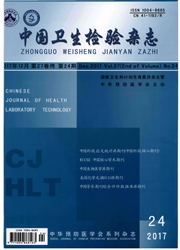

 中文摘要:
中文摘要:
目的考察野生与人工栽培白及中重金属及有害元素含量情况,并对污染情况进行评价。方法收集不同来源的野生与人工栽培白及药材,用原子吸收光谱法测定样品中铅、镉、铜含量,原子荧光分光光度法测定样品中汞、砷的含量。以《药用植物及制剂进出口绿色行业标准》和污染指数方法对野生和栽培白及药材中重金属及有害元素进行评价。结果被测定的5种重金属及有害元素分别在选定的范围内线性关系良好(r≥0.999),铅、镉、铜、汞、砷的检出限分别为8μg/kg、0.03μg/kg、10μg/kg、4μg/kg和6μg/kg,回收率为95%~105%,RSD〈8.8%,精密度RSD〈5.1%,重复性RSD〈9.6%,表明该方法可行。采用所建立的方法对52批不同来源的白及药材中重金属及有害元素的含量进行了测定,结果人工栽培白及药材综合污染指数明显小于野生白及药材。结论人工栽培白及因其生长环境因素较野生白及药材可控,故其重金属及有害元素较野生白及更易控制。
 英文摘要:
英文摘要:
Objective To investigate and evaluate the content of heavy and hazard metals in Bletilla striata which was cultivated in wild or artificial cultivationso as to evaluate the pollution status. Methods To collect different sources of wild and cultivated Bletillae striata medicinal materials,determination of lead,cadmium,copper content in the sample was conducted by atomic absorption spectrometry. Mercury,arsenic content determination in samples was conducted by atomic fluorescence spectrophotometry. With "medicinal plants and preparations for the green trade standard"and pollution index method to evaluate the heavy metals and harmful elements in wild and cultivated Bletillae Striata. Results The determination of the five heavy metals and other harmful elements presented a good linear relationship in the selected range( r≥0. 999). The detection Limit of lead,cadmium,copper,mercury and arsenic is 8 μg / kg,0. 03 μg / kg,10 μg / kg,4 μg / kg and 6 μg / kg,rspectively for,with the average recovery between in 95%- 105%,RSD 8. 8%,precision RSD 5. 1%,repetitiveness RSD 9. 6%,which showed that this method is feasible. The content of heavy metal and harmful elements in 52 batches of wild and cultivated Bletilla striata from different areas were determined. The comprehensive pollution index in the cultivate samples were significantly less than wild samples. Conclusion The cultivated Bletilla striata are more controllable than wild samples because of theirzgrowth environment factors are under control.
 同期刊论文项目
同期刊论文项目
 同项目期刊论文
同项目期刊论文
 期刊信息
期刊信息
